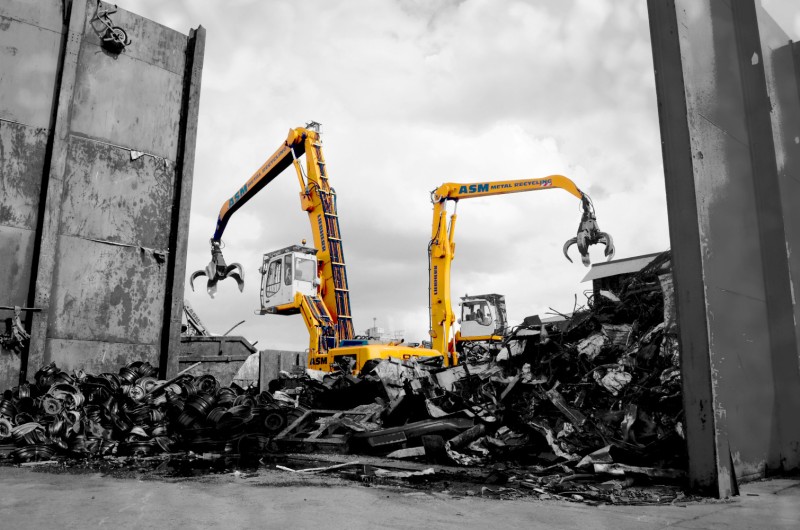later post | index | earlier post
How is metal recycled and how does it work?
Wednesday, 7 August 2024

Metal is currently one of the biggest recycling sectors in the UK. This is because, as a raw material metals can be easily recycled without damaging its original properties.
Aside from the environmental benefits that come from recycling metal, there are several advantages to recycling metal, including:
- Protecting natural resources by reducing the need to mine raw materials.
- Reduce energy usage by not processing raw materials (recycling metal uses around 75% less energy than creating new metal, so it’s an invaluable activity).
- Economic benefits thanks to job creation and local industry investments.
- Unlimited recycling opportunities meaning indefinite landfill diversion.
When it comes to the recycling process itself, there are numerous companies for you to choose from. At ASM we have decades of industry experience that enables us to specialise in the smooth facilitation of metal recycling.
Which metals can be recycled?
While most metals can be recycled, some are more commonly reused than others. This will come down to how easy a particular metal is both to find and process. Scrap metals are categorised into ferrous and non-ferrous groups before being processed.
Ferrous metals include things like cast iron, carbon steel, mild steel, and wrought iron. Because they are generally magnetic and contain iron, these types of metals are popular in the car industry, while their strength also makes them useful for construction.
These types of metals are quite commonplace and usually found in domestic tools, hardware, and household appliances. They are also contained within larger objects like vehicles (around 25% of a car’s body is made from recycled materials) and shipping containers.
Non-ferrous metals such as aluminium, silver, titanium, and copper are generally more malleable. This means they can be used for anything from taps and ornaments to vehicle batteries and wiring.
How big is the metal recycling industry?
Globally, the metal recycling industry is huge. According to IBISWorld, the UK scrap metal recycling industry generated £6.1 billion in 2022.
Operators in the industry vary from small, family-owned businesses to international companies. The industry is structured like a pyramid, with the smaller independent firms collecting the metal and then passing it on to major reprocessing plants.
How is metal recycled?
Through heat. The metal is cleaned and put in a furnace to create a molten metal solution. The solution is then checked for purity and, if needed, is exposed to either additional metals or gases to adjust the levels.
The molten metal is then poured out of the furnace and formed into different shapes such as ingots, rods, billets, and slabs, depending on the end purpose. On some occasions, metals are pulverized into powder or transported from the plant in liquid form to be used to create other components and products.
How can metal be recycled?
At ASM we carry out a number of operations involved in metal recycling, including:
- Baling and compacting. On some occasions, scrap must be moved to larger processing plants. They’re usually baled to aid stacking and transporting (often after shearing*).
- Shredding. This is the reduction of waste goods down to fist-sized lumps of metal using highly efficient shredding machines. Modern shredders are incredibly efficient, capable of processing a car in less than 10 seconds.
- Hot air blasting. A lot of metals are coated with lacquer (aluminium cans, for example). As a result, they’re passed through a blower – which blasts the metal with hot air to burn off any remaining residue.
- Collecting, weighing, and processing scrap metals. The major task, of course, is dealing with a wide range of different suppliers and working with local authorities to ensure that all of the metal is dealt with appropriately. A metal processing plant will work with hundreds of different bodies throughout the year.
- Media separation. Even once the metals have been completely sheared* and shredded, unwanted waste materials can still be found in the mix. Media separation is therefore an important task used to extract ferrous metals, textiles, lighter plastics, and non-metallic waste.
*Shearing scrap metal is when large pieces of scrap metal are cut down to make them easier to repurpose.
Recycle your scrap metal with ASM
Wondering ‘how to recycle metal’? If you’re planning on recycling your scrap metal, ASM Metal Recycling offers highly competitive rates for both ferrous and non-ferrous metals. This means that by recycling your scrap metal with us, both the environment and your bank balance will benefit.
later post | index | earlier post
Recent posts
- What to do with radioactive scrap metal
- How does metal recycling benefit the economy and the environment?
- 5 common metals that can be recycled
- How does metal recycling work?
- How to Sort Metal for Scrap
- How to classify the different types of waste your business produces
- What is WEEE waste?
- Can iron be recycled in the UK?
- What has the most copper in it to scrap?
- How to better understand scrap metal pricing
- Is there a link between copper and brass prices?
- How to make money from cable scrap
- How many different types of copper are there?
- What can I sell to a scrap metal yard?
- Preparing for the collection of scrap metal